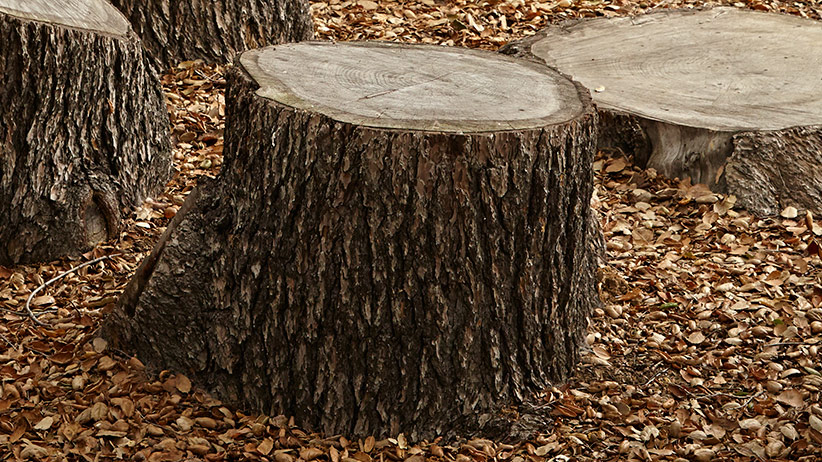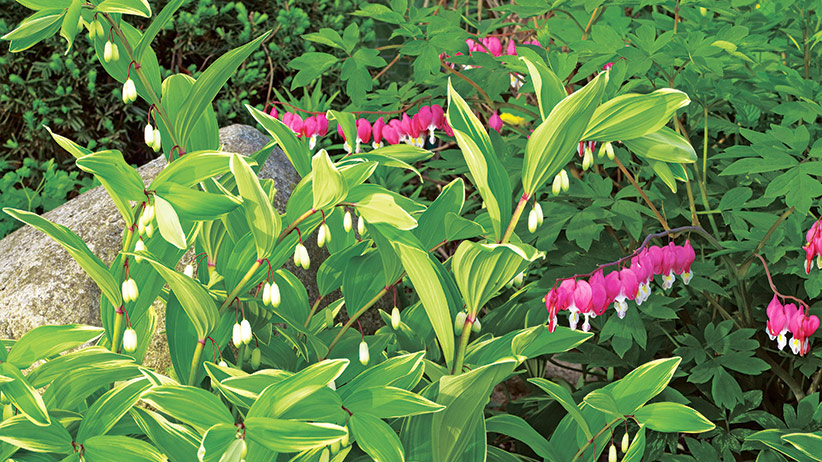Introducing Our 2023 Garden Gate Reader Garden Award Winners!
When Philip Zhao and Tingshu Hu moved to their suburban home in northern Massachusetts nearly 20 years ago, it took them 2 hours to mow the 1-acre lawn. This wasn’t how they wanted to spend their time outdoors. So they set a goal of reducing their lawn by half, which they hoped would cut down on water usage and lawn treatments. Now they tend a couple of large vegetable plots, countless flower and shrub borders, three ponds, two greenhouses and even a flock of chickens. Watch our Talk & Tour video interview above and read more about this couple’s creative efforts and see the great-looking results below.

A winning team
Tingshu, a professor of electrical and computer engineering, and Philip, a computer engineer, have planned and executed every project themselves. Along the way, they’ve experimented with new plants, faced challenges and built some pretty innovative garden structures. All of these factors led us to select them as Garden Gate’s 2023 Reader Garden Award Winners.
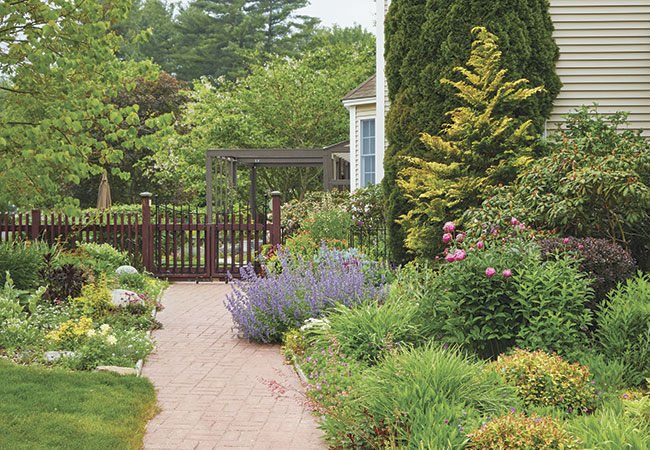
Entry garden with multiseason interest
The beautiful border along the front path above holds a diverse mix of shrubs, perennials and annuals, and plant lover Tingshu has carefully planned it to display color in all four seasons. She credits the new perennials’ and shrubs’ fast growth to the chicken manure compost they used to improve the soil throughout the garden.
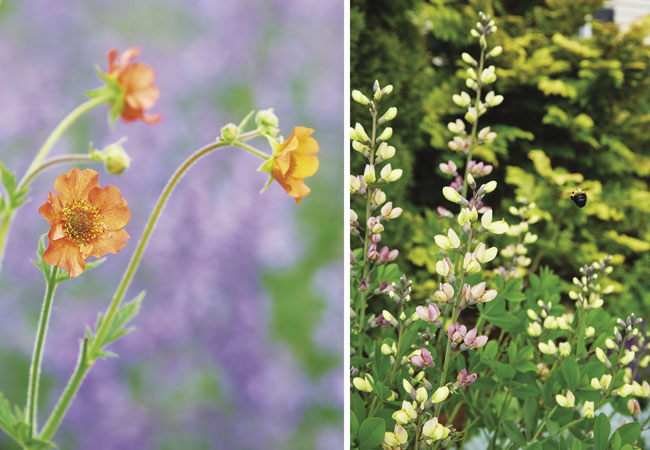
Spring and summer flowers
In spring, visitors are greeted with bulbs and spring-flowering shrubs. Summer perennials include false indigo (Baptisia australis), geum (Geum hybrids), salvia (Salvia spp. and hybrids) and gloriosa daisy (Rudbeckia hirta).

Fall and winter flowers
In fall, dahlias (Dahlia hybrids) and zinnias (Zinnia elegans) add their color to the mix. Finally, in winter, conifers of many colors, such as golden falsecypress (Chamaecyparis spp. and hybrids), green arborvitae (Thuja occidentalis) and dwarf blue spruce (Picea pungens ‘Globosa’), keep things interesting. But the couple’s garden journey actually began in the backyard. Keep reading to see where it all started.
You Might Also Like:
Tour the 2022 Reader Garden Award Winner's Garden!
Front Yard Garden with Multiseason Appeal
Perfect Pathside Plants for Your Garden
Four-Season Entry Garden Plan
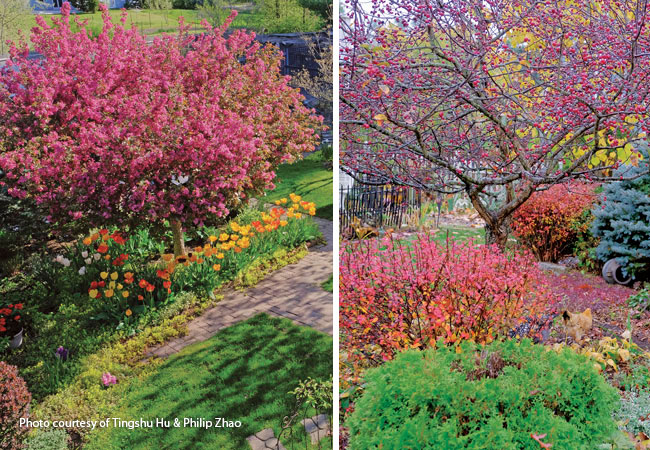
A beautiful backyard destination
When the couple started their first garden project in the backyard, they each had a goal in mind: Tingshu wanted a showy centerpiece tree in the backyard. She chose a ‘Prairie Fire’ flowering crabapple (Malus hybrid) for its bright pink blooms in spring, yellow fall foliage color and red berries in late fall and winter. The birds enjoy eating the berries, and in turn, she gets to watch them feast out the window from her dining room table.
Philip wanted a backyard destination that included a seating area and a pond. They combined their desires for a centerpiece tree and a destination spot into the design above. In keeping with their plant selection philosophy, they looked for companion plants that would add color in every season.
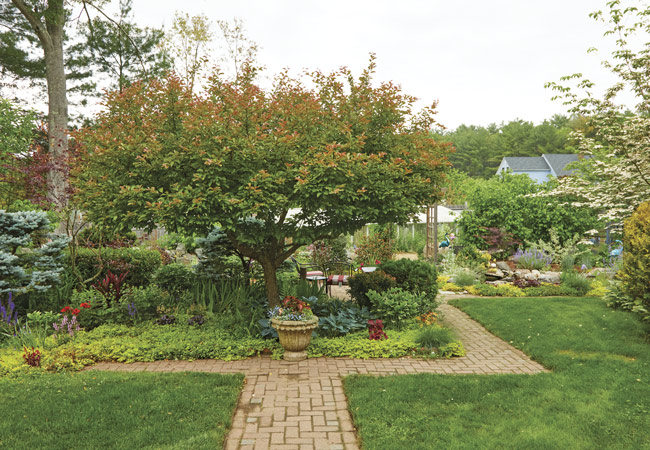
Garden design tip
A tapestry of low-growing plants, such as variegated wintercreeper (Euonymus fortunei, golden creeping Jenny (Lysimachia nummularia 'Aurea') and ground cover sedums (Sedum spp. and hybrids), keep weeds down between other plants in the beds above. When Tingshu places a smaller plant, such as coral bells (Heuchera hybrids), in this area, sometimes she encircles it with edging to keep the more-aggressive ground covers from overtaking it.
Pathways frame the garden
Philip initially planned a path to curve through the backyard, but once the pavers arrived, he realized that a straight path would require him to cut a lot less stone. So they decided upon the layout above instead. Now they’re happy that they made that last-minute change, as the straight lines frame the exuberant, always-changing beds and borders nicely.
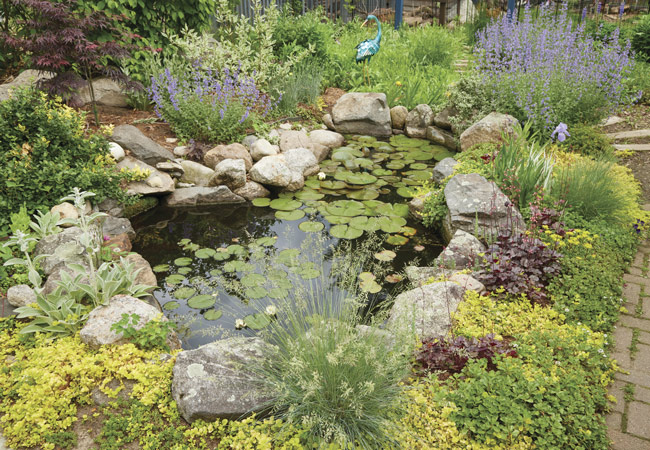
Self-sustaining pond
As you look from the house toward the back of the property, the path leads to a small patio and the 9×12-foot pond above. Here, the water lilies (Nymphaea hybrids) and other plants filter the waste from the goldfish, which eat mosquito larvae and other insects. In fact, Philip says that he’s mostly stopped filtering the water or feeding the fish because the pond nearly takes care of itself. They just need to divide the water lilies every couple of years.
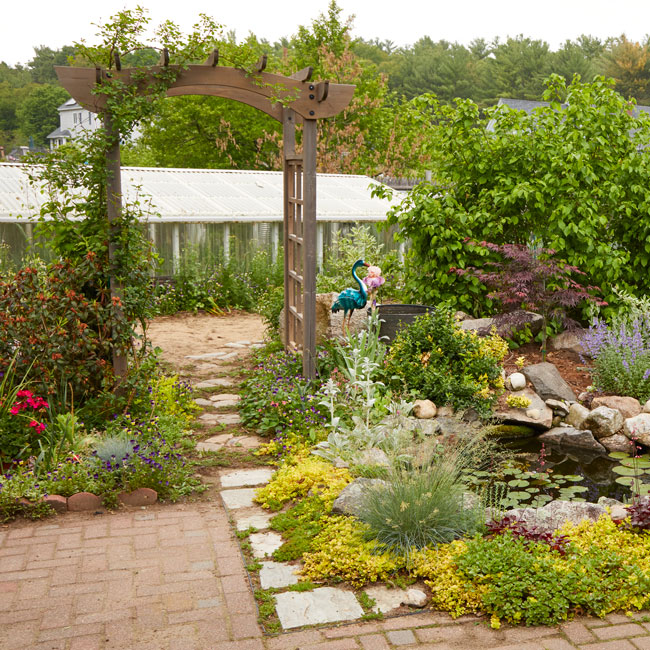
Practical (and subtle) greenhouse
A few years ago, they lost a tree at the back of the property and decided to install a greenhouse in that spot. The couple needed more space for seed starting, overwintering tropical plants and growing vegetables year round in the zone 5 garden. You can just see the light-colored roof of the 26×10-foot structure in the photo above. Because they didn’t want the structure to dominate the view in the backyard (and wanted to use geothermal energy to power it), the couple and their family hand dug the 6-foot-deep foundation. This means that it rises only 5 feet above the soil’s surface and to enter, you step down into the partially sunken greenhouse.
In winter, they grow leafy greens. And sometimes the cherry tomatoes will last until Christmas. Tingshu also overwinters myrtle (Myrtus compacta) and figs (Ficus carica) in the structure and gets an early start on vegetables as well as cannas (Canna hybrids) and dahlias, so they’ll start blooming as early as possible outdoors.
You Might Also Like:
Starting Seeds with Soil Blocking
DIY Garden Projects
Grow Greens in This DIY Vertical Garden
Quarantine Garden Projects
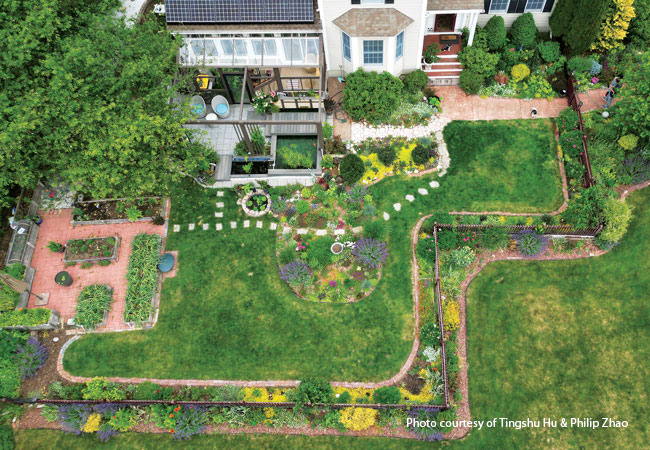
The front-yard garden started with a picket fence
Eventually the couple had filled most of the backyard and sideyards with gardens. And then they decided to enclose part of their front yard with a 3-foot-tall picket fence to give their Havanese dogs, Didi and Luke, a place to run. But Tingshu couldn’t just leave a perfect backdrop like a picket fence plain! So the couple started digging in 3-foot-wide perennial borders on both sides of the fence so that both they and their neighbors could enjoy the show.
Then they divided and moved ornamental grasses, Russian sage (Perovskia atriplicifolia), catmint (Nepeta racemosa) and other perennials from other spots in the garden into the beds. As the garden has matured, they’ve found themselves dividing more and more, whether out of necessity or just to share. Philip says, “A couple of times a year we open up our garden to friends. Most of the time they don’t leave empty-handed.”
At 3 feet tall, the picket fence in the front yard isn’t technically tall enough to deter deer, but they don’t seem to jump it. The couple thinks the 3-foot-wide plantings on either side may be part of the reason. (And there’s plenty for deer to eat outside the fence too.)

A practical solution for grub damage in a lawn
When grubs killed off a section in the middle of the front lawn recently, instead of reseeding it with turfgrass, Tingshu and Philip planted the area with drought-tolerant perennials you can see above, such as dianthus (Dianthus spp. and hybrids), coreopsis (Coreopsis spp. and hybrids) and tall sedum (Hylotelephium telephium).
A robotic lawn mower is the newest addition to the front yard. The perennial borders next to the picket fence used to have cut edges, but to make the lawn mower work more smoothly, Philip has been installing a paver edging this year.
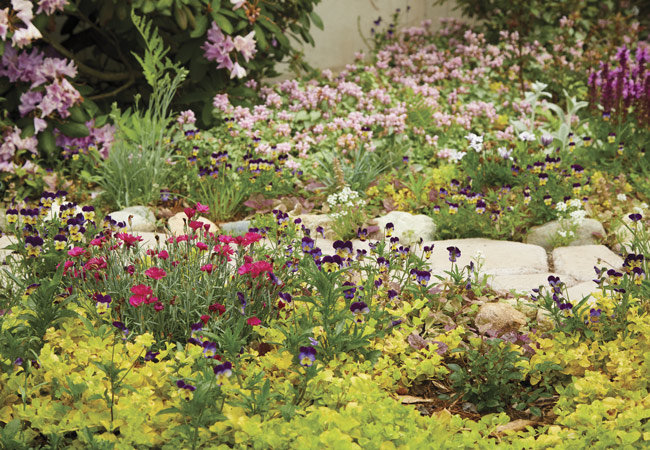
Tight plantings keep weeds down
Near the front door, low-growing plants weave together so tightly that they keep weeds down.
A few favorite low-growing plants:
- Johnny jump-up (Viola tricolor)
- Dianthus (Dianthus spp. and hybrids)
- Sweet alyssum (Lobularia maritima)
- Creeping Jenny (Lysimachia nummularia)
- Ground cover sedums (Sedum spp. and hybrids)
- Blue fescue (Festuca glauca)
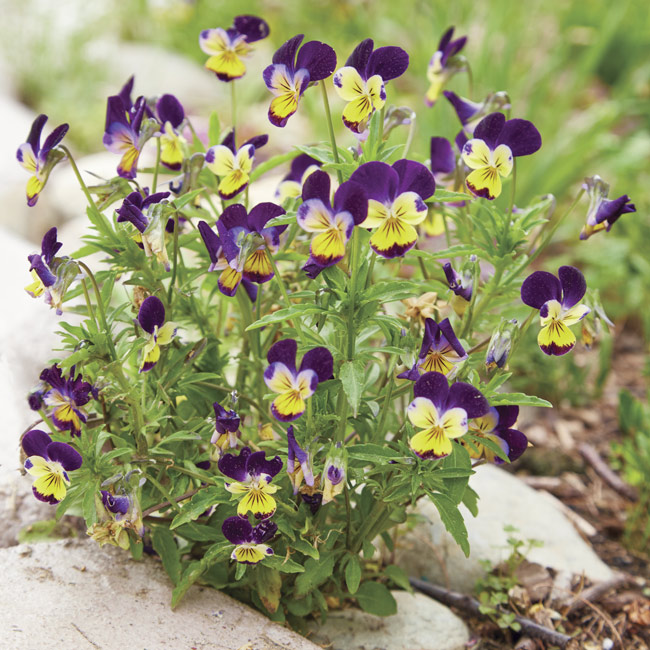
Reseeding plants mean the garden is always changing
Many of the plants, such as the Johnny jump-ups sweet alyssum and gloriosa daisy, reseed, so it never looks the same from year to year, or even season to season. As the weather heats up in summer, the Johnny jump-ups start to fade and the gloriosa daisies take over. When the reseeders emerge, Tingshu edits the garden, leaving patches in areas where she wants them, and pulling them where they would elbow out other plants.
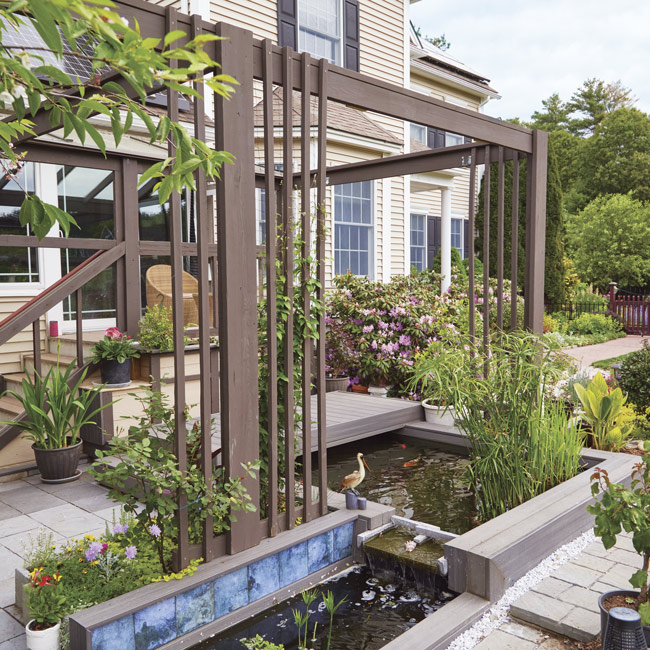
Escape to a tranquil patio & water garden
Inspired by shallow koi ponds he’d seen in Japan and China (and limited in depth by buried fiber optic cables), Philip built this 1-foot-deep pond last year. Not only is it pretty to look at, but he designed it to run the water through an aquaponic planter box that he built, where the plants use the fish waste and the filtered water is returned into the pond. This system reduces the frequency with which the filters need cleaning throughout the year.

Indoor tank protects the fish in winter
The pond is too shallow to hold the fish safely over the winter in this zone 5 garden, so the couple built another 250-gallon tank in the indoor sunroom above. It uses the same technique to run the waste water through aquaponic planters.
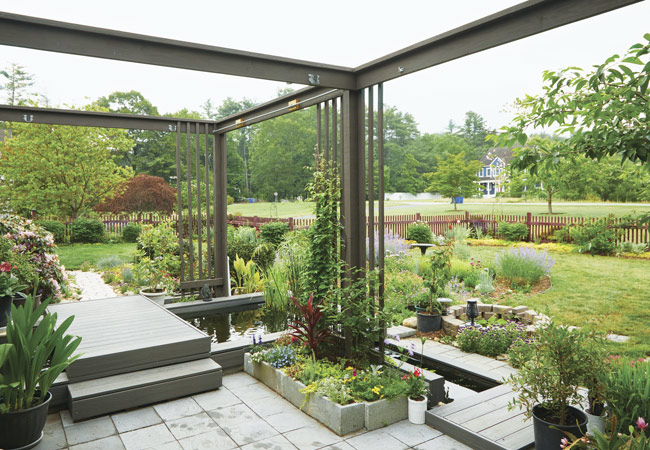
Garden details
With the sound of water, a structure overhead and a place to sit and watch the fish, this is a nice spot to sit with morning coffee or during a work break.
Design tip
Giving fish a place to hide is essential to protecting them from predators like raccoons and herons. The walkway that spans the pond provides a nice vantage point for people but also offers cover for the fish.
You Might Also Like:
Plants that Are Toxic to Fish
How to Get Rid of Algae from a Garden Pond
Tour a Marvelous Moss Garden
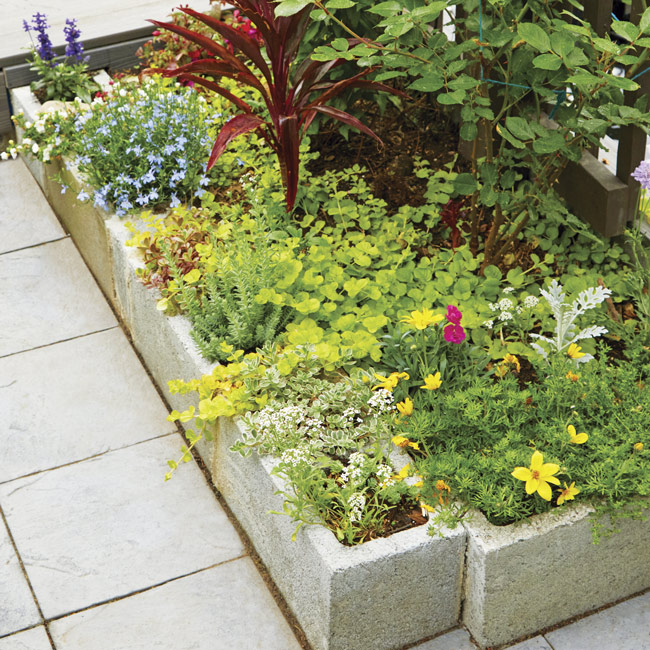
Plants in every possible spot
The pockets in these concrete blocks are perfect for small annuals, such as Yellow Charm™ bidens (Bidens ferulifolia), Laguna® Sky Blue lobelia (Lobelia erinus) and sweet alyssum. The blocks also create a raised bed for the climbing rose (Rosa hybrid) and clematis (Clematis hybrid) that Tingshu is training up the posts of the arbor.
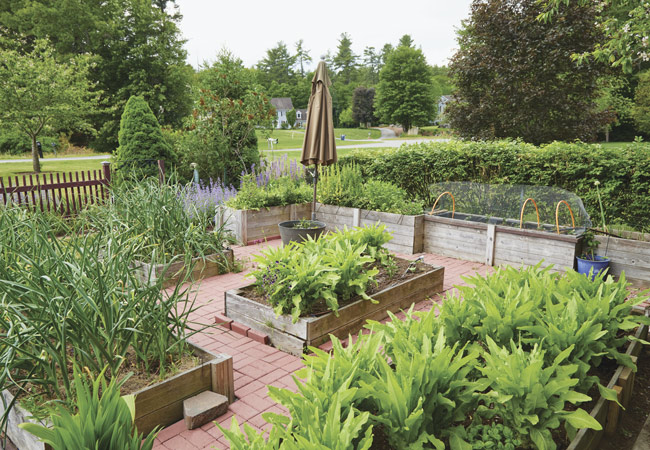
Front yard vegetable gardens
Although the couple has planted more than 100 trees and shrubs throughout the property, the front yard is sunny, so it’s the perfect place for the five raised vegetable beds of various sizes. This is where they grow garlic for the tasty scapes (flower stems) and the bulbs, as well as stem lettuce, an Asian green grown especially for its stems, rather than its leaves. Tingshu sautes and quick pickles them.
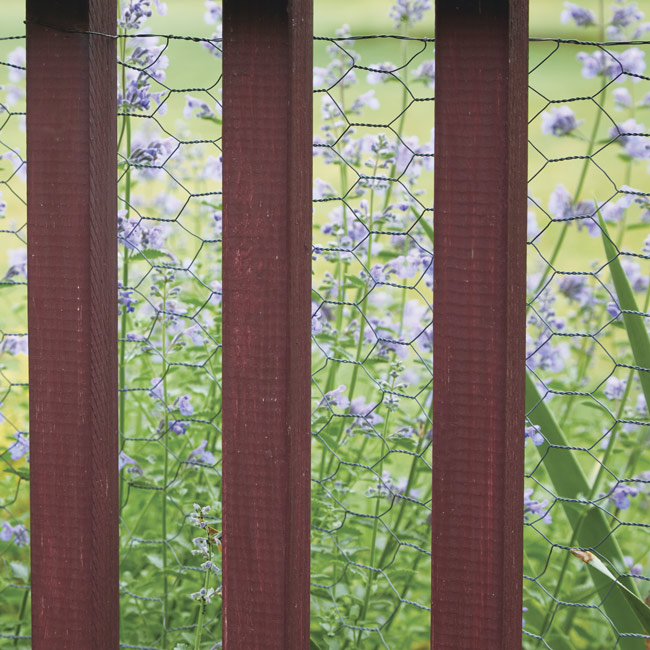
How to prevent rabbit (and other critter) damage
Although the picket fence does a great job of keeping Didi and Luke in the yard, it doesn’t keep the rabbits out. So Tingshu and Philip stapled a length of chicken wire to the fence to prevent rabbits from browsing in the vegetable beds and flower borders. To make it extra secure, they buried the chicken wire 3 to 4 inches into the soil as well.
Rabbits aren’t the only critters that visit their garden: Voles eat the lilies and tulips, squirrels seem to enjoy the fruit trees, and a black bear even occasionally wanders through, especially when the sweet corn is ripe. With all the rain they had this year, slugs also started eating many of their perennials’ leaves.
No matter what the challenge, they approach it scientifically, researching options, then testing different methods for effectiveness.
Secure fences seem to be the biggest help against most four-legged pests. But so far, winter trapping has been the best defense against the voles who eat the roots of blue fescues, shrub roses, and lots of other plants in every season.
Weather challenges in the garden
This year’s biggest challenge, though, was the weather: Nothing breaks a gardener’s heart like a hard freeze after all of the trees and shrubs have budded in May. They lost most of their apple, pear and peach crops, all but the very bottom rhododendron blooms and the first flush of rose buds. Although you can drape row cover on some things to protect them in a cold snap, it’s impossible to get to everything. On the bright side, however, because they had so much rain in the summer, they didn’t need to irrigate much.
Every season and every year is different — new projects, new challenges and nature’s surprises keep gardening interesting.
You Might Also Like:
Enter Your Garden in the Reader Garden Award!
Watch Our Garden Tour Playlist on YouTube









